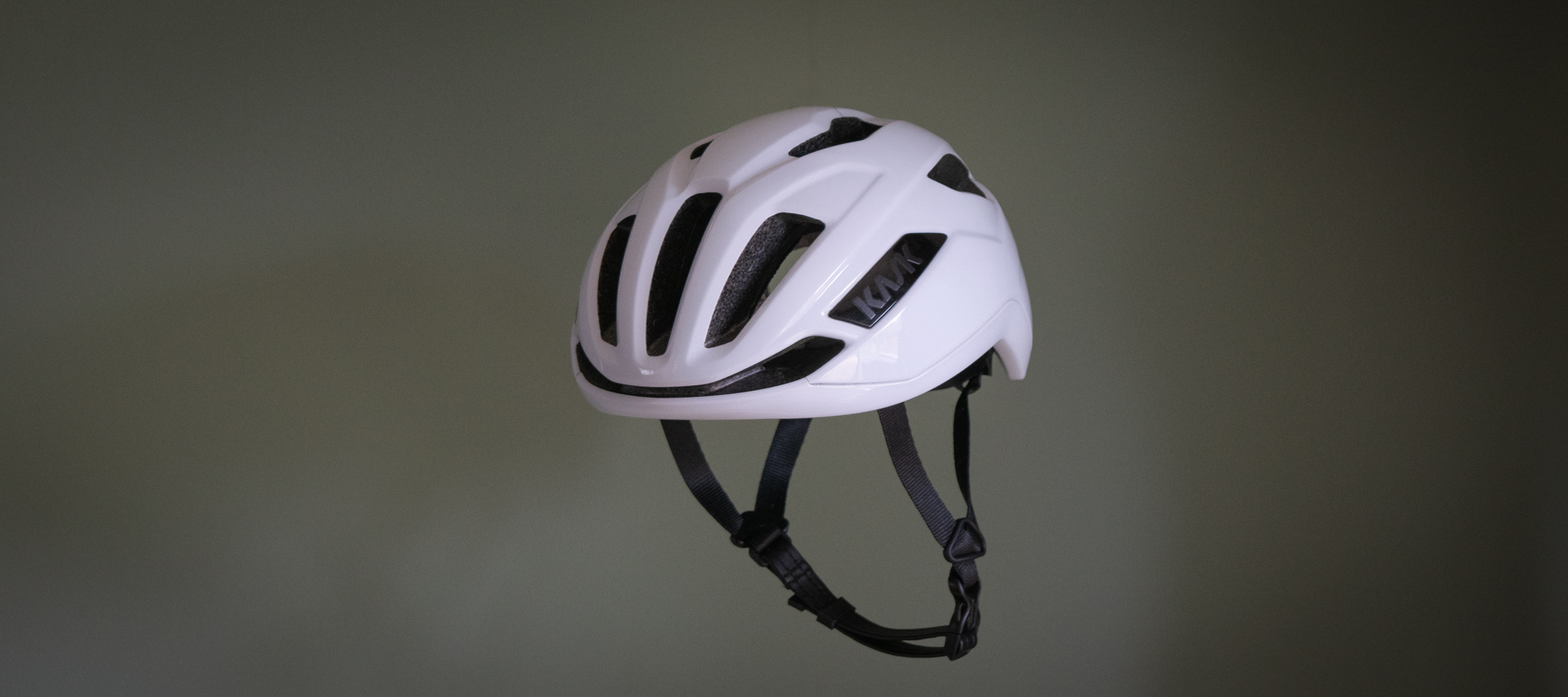Cyclingnews Verdict
The Sintesi has performed really well over months of testing and doesn't look out of place amongst more premium helmets. It isn't perfect, and the retention system is on the basic side but it's been comfortable and has done its job well.
Pros
- +
Affordable price point
- +
10+ colour options
- +
Lightweight
Cons
- -
Ventilation isn't brilliant on hotter days
- -
The retention system is a little on the basic side
- -
Lack of MIPS or Virginia Tech score may put some off
You can trust Cyclingnews
The Kask Sintesi helmet was launched in November 2022, and we covered it briefly at the time as part of our monthly tech roundup. I've been riding in my white test model since last winter and am now ready to deliver my full review of the helmet.
The Sintesi is Kask's cheapest helmet and is billed as being not just a road helmet but suitable for gravel and commuting etc. It's available in 11 block colourways from white to wine red and Sahara (you guessed it, a sandy colour) and features some of the usual Kask stylings that feature on more expensive models. Such as the brand's synthetic leather chinstrap.
Sintesi, in case you were wondering translates to synthesis in English and is defined by the Oxford English Dictionary as "The putting together of parts or elements so as to make up a complex whole". Kask says the Sintesi is a versatile helmet that suits road, gravel or commuting work. I'm assuming that's where our coming together of different parts comes from in the case of the Sintesi.
As mentioned above, the helmet is Kask's budget offering and the cheapest in the lineup at £90, at the moment you can also pick it up for less than £60 in the UK and you won't find too many quality, performance-orientated helmets for less than that. It's also a competitive weight, weighing less than many of the helmets in our budget bike helmets guide, but is it any good? Keep reading to see what I made of it after several months of riding and a few thousand miles.
Price: £90 / $1214 / €105
Available Colours: Black, white, grey, red, wine, sea ice, tangerine red, oxford blue, Sahara, aloe green, light blue
Rotational Impact Technology: Kask WG11
Weight: 241 Grams (M)
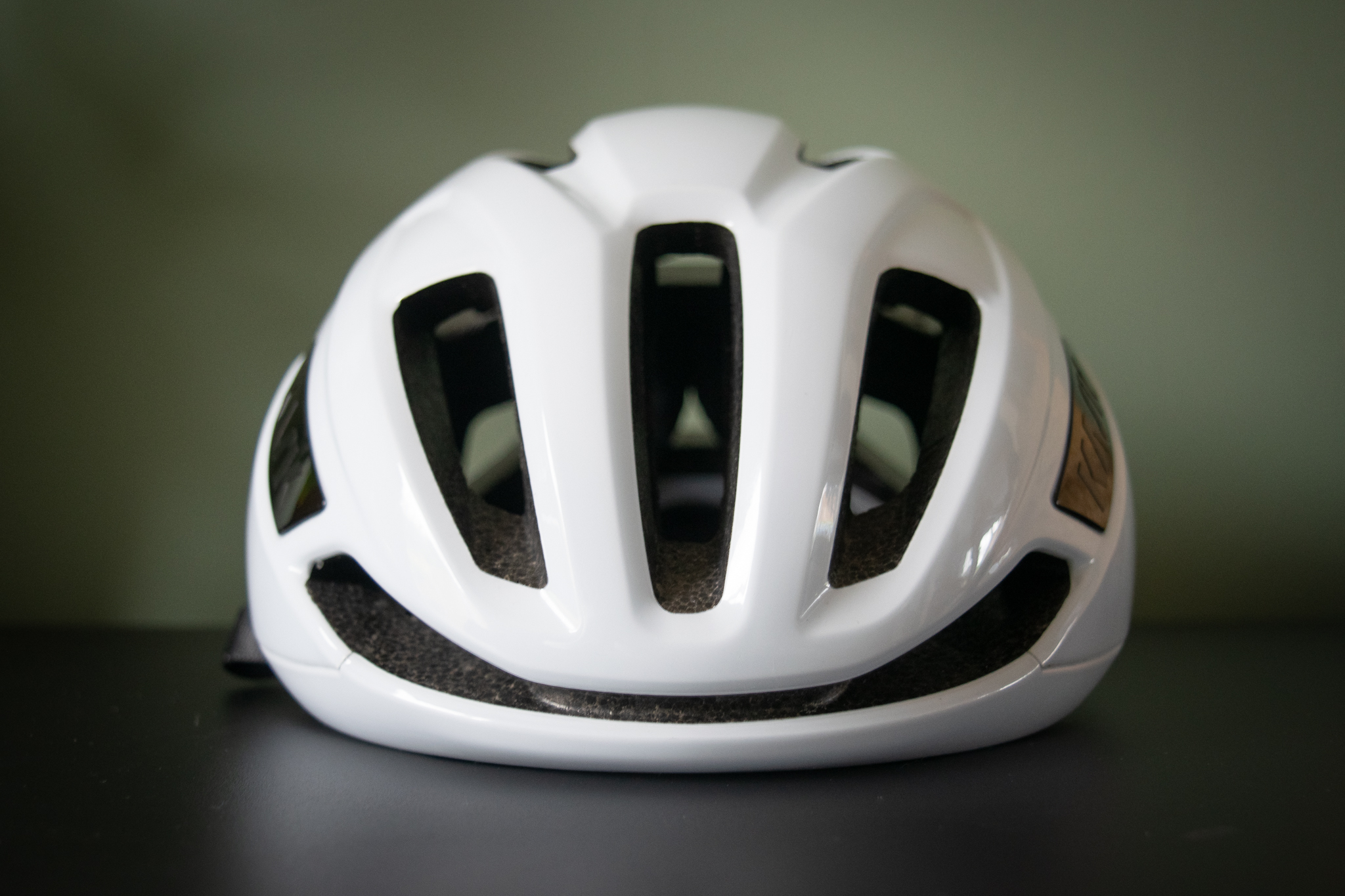
Design and Aesthetics
The Sintesi features a standard EPS (expanded polystyrene) inner shell, polycarbonate outer shell and Blue Tech padding on the inside which is both antibacterial and antistatic. There are three pads in total on the inside. A larger one-piece section, and two individual smaller pads. Spare pad sets are also available from Kask. Compared to Kask's top-end options the Sintesi features none of the carbon fibre plates that the more recently launched Elemento uses, which, at £335 / €375 / $400, is over triple the price of the Sinetsi.
The Sintesi is pitched as being suitable for Road, gravel, and commuting use and there is evidence of this motive in the design and shape of the helmet. Most obviously to my mind in the rear left and right sections just rear of the ears. The helmet body drops down a little more in this area and looks like more urban or commuter-focused helmets. For me though, the helmet sits on the right side of this divide, which means it still looks at home on the road amongst other performance road helmets. It's also still a competitive weight at 241 grams on my scales for a size Medium. I did find that with the slightly dropped sections rear of the ears, some sunglasses arms fouled a little bit and took a bit of positioning to get right but this will depend on what shades you're using.
On the topic of sizing, the Sintesi is available in M - 52-58cm and L - 59-62cm which should cover the majority of head sizes. The helmet features thirteen vents, though there is room for more on the helmet, and an obvious location for an extra two at the front of the helmet is 'blanked off' and instead features black Kask embossed inserts. There is also a small reflective sticker on the rear of the helmet just above the retention dial. The 'filled in' sections do however mean that some 'solid' or unvented sections of the helmet give it an aero road look which if nothing else aids its ability to at least aesthetically straddle riding disciplines effectively.
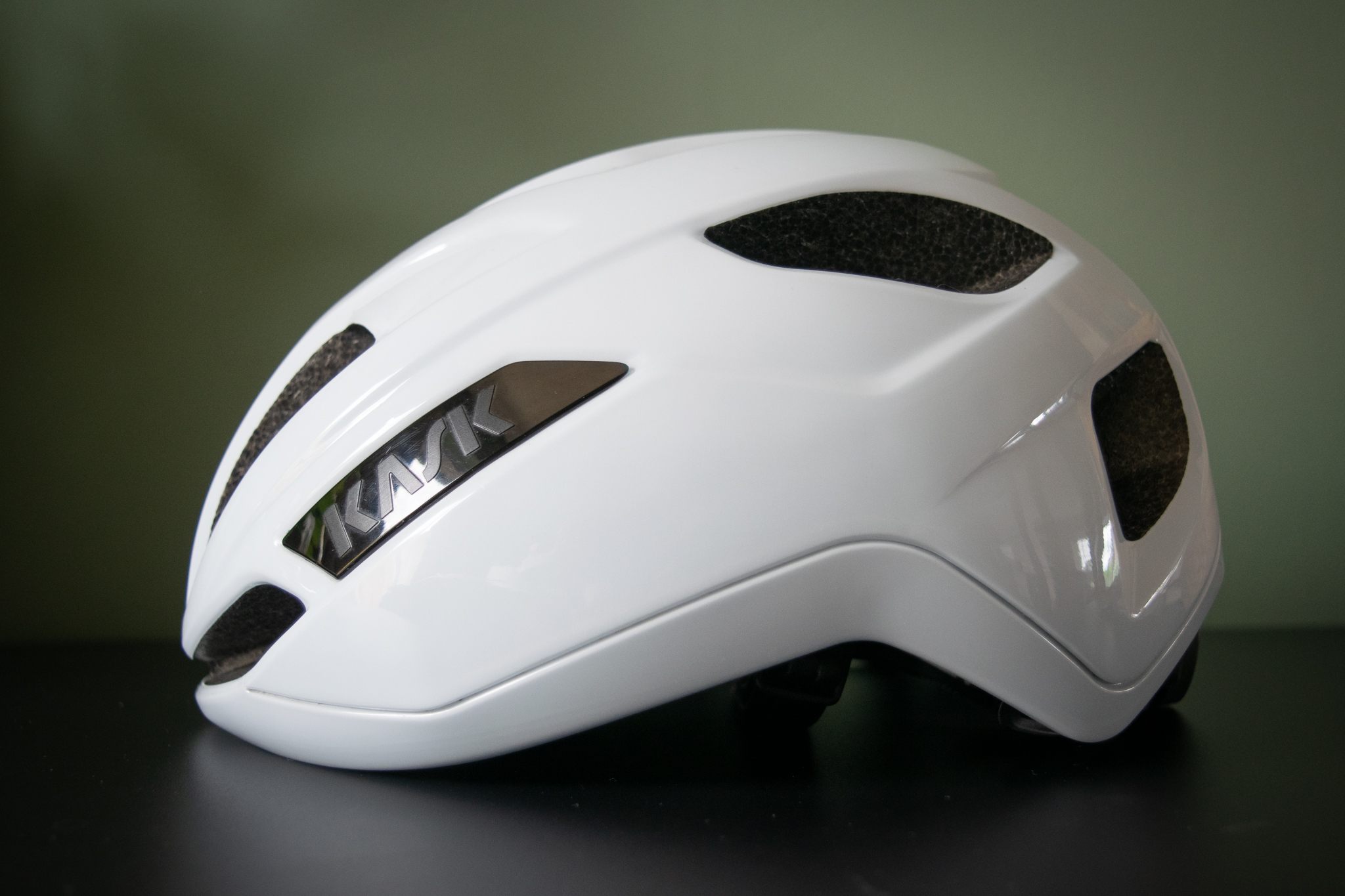
The retention system is what Kask calls its Ergo fit system, which the brand says is a new system engineered to provide fit and comfort. Fit is adjusted via a plastic dial, and toothed inner wheel and plastic arm sections. The wheel has a rubber outer gripper which gives a decent feel but it is a relatively basic plastic setup. What took the most getting used to for me at first was the unfixed position of the retention system on the helmet's rear straps. This meant I had to just move the adjustment section down the back of my head a fraction each time I used it or I'd face some discomfort when heading out the door if it wasn't in the right place.
The black helmet straps themselves are easy to adjust though I didn't need to fiddle too much and they conveniently came pretty much spot on for me out of the box. The left-hand one gets a rubber 'Italy-made' tab and flag. And the trademark Kask synthetic leather chin strap still features. The Kask embossed plastic buckle didn't cause any issues for me either.
Kask helmets largely feature the brand's own in-house WG11 rotational impact testing which Kask says exceeds industry standards, and helmets feature the WG11 sticker if they meet this standard (it's on the rear of the Sintesi). The Sintesi also complies with CE EN 1078, CPSC 1203 and AS/NZS 2063 European standards. Though the Virginia Tech helmet testing is seen as something of a safety benchmark, not many Kask helmets (and not the Sintesi, crucially for this review) have been sent for testing there and WG11 is used over MIPS technology.
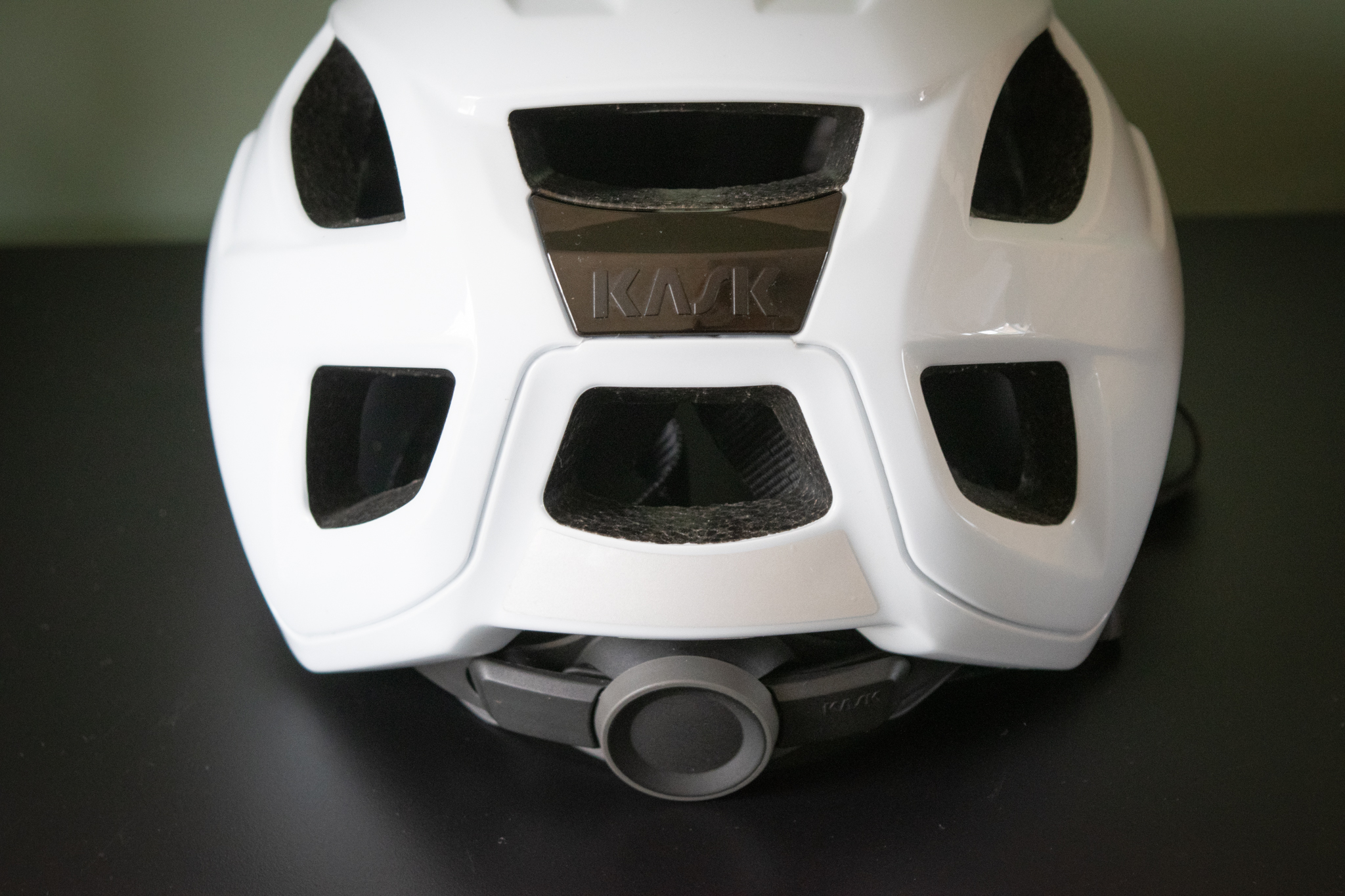
Performance
I've ridden a few thousand miles in the Sintesi since I received it. I've used it for cold winter rides, and fast summer chain gangs. I've also travelled with it and ridden in Mallorca and Italy, and ridden off-road testing gravel bikes. I feel by now I've got a good handle on what the helmet is about and what it does and doesn't do so well.
Though ventilation is cited as being a strong point for the Sintesi, I've felt that it does get a bit hot and sweaty. Most notably when climbing in hot conditions or when working hard on climbs where a lack of wind can quickly mean you end up feeling hot. I've often arrived at the top of a few relatively short local climbs whilst working hard with the front pad pretty well saturated this summer, and have had to do the always-uncomfortable squeeze and de-sweat of the pad against my brow. So I do think ventilation could be a bit better. It's probably my only real gripe with the helmet. That being said most of my riding has been on the road and if you are using the Sintesi to spin into work through a town or city this would probably be a non-issue, unless you're regularly commuting at threshold.
Though the retention system isn't a premium one, it does work very effectively and really locks the helmet down securely. Once adjusted it's not going anywhere. For the money, I can't fault it really and for the price point, you shouldn't expect a top-of-the-line all-singing and dancing retention system. You also can't store your shades anywhere, but I always stick them backwards on my neck anyway so this wasn't a problem for me.
Once I had got the hang of just moving the rear cradle down my head slightly when putting the helmet on (it pivots from the front on two small torx bolts) I could always achieve a really comfortable fit. It only took a handful of rides to crack this, and I think it's fair to say any new helmet you try will have its own feel and different retention systems will take a little bit of adapting too.
I've always felt comfortable in the helmet and have never experienced any discomfort or niggles. I should also point out that as a bald man, I don't have the luxury of any Tadej tufts to cushion my head so potential discomfort can be easily noticed, but the Sintesi has been very comfortable the whole time I've been using it.
Wear-wise, the Sintesi still looks pretty much brand new. There have been no failures or issues with it of any kind, the pads are all still in excellent condition, and as mentioned I've travelled with it, and have given it a good rinse and wash in the shower after hours spent climbing under the Mallorcan sun and back home. Full points for durability.
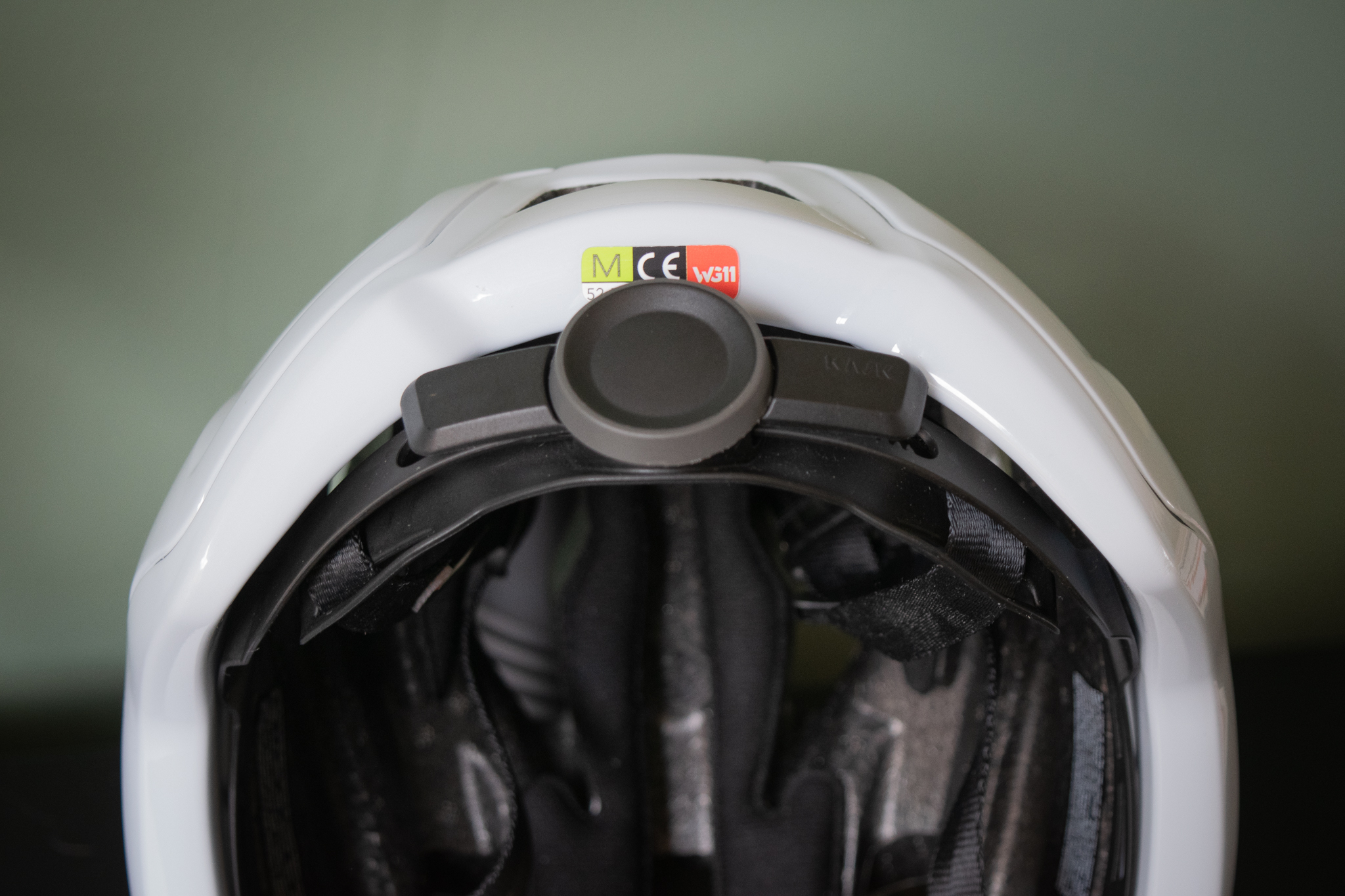
Verdict
The Sintesi is a good quality helmet at an attractive and relatively affordable price point. I can't really fault it in many departments aside from finding it a bit too sweaty on hot days or when riding hard. Once I got used to the fit it's been completely comfortable with no niggles or other issues.
Yes, the retention system isn't as refined as other more expensive helmets, but it does its job well which is to keep the helmet securely and comfortably on your head. As I said above there are plenty of more expensive options out there and in the Kask lineup for that matter if you want to drop more cash.
I'd love to know how the Sintesi would measure up in a wind tunnel test, lots of my riding friends assume it's an aero or aero-focused helmet. It's purely a gut feeling and I have no data or scientific testing to back it up but I feel with the filled-in side vents and overall shape it may do okay aero-wise and be quite quick. I certainly haven't felt it holding me back.
If you like the look of the Sintesi and are looking for an affordable helmet that can do a bit of everything, and a lack of MIPS or Virginia Tech score isn't an issue for you, the Sintesi could well be a really great option.
| Design and aesthetics | I think Kask have done well in blending road and commuter or urban styling into one package that looks good | 7/10 |
| Comfort | Really comfortable, I had zero issues once I had figures out the fit | 8/10 |
| Ventilation | I feel the Sintesi isn't brilliantly ventilated and found it a bit hot at times | 6/10 |
| Safety | Adheres to EN standards and the in house WG11 test. No MIPS or V. Tech though | 8/10 |
| Value | For the money, I think the Sintesi is a solid helmet | 9/10 |
| Overall | Row 5 - Cell 1 | 76% |

Tom joined the Cyclingnews team in late 2022 as a tech writer. Despite having a degree in English Literature he has spent his entire working life in the cycling industry in one form or another. He has over 10 years of experience as a qualified mechanic, with the last five years before joining Cyclingnews being spent running an independent workshop. This means he is just as happy tinkering away in the garage as he is out on the road bike, and he isn’t afraid to pull a bike apart or get hands-on with it when testing to really see what it’s made of.
He has ridden and raced bikes from an early age up to a national level on the road and track, and has ridden and competed in most disciplines. He has a keen eye for pro-team tech and enjoys spotting new or interesting components in the wild. During his time at Cyclingnews, Tom has already interviewed some of the sport's biggest names including Mathieu van der Poel, Tadej Pogačar and Alberto Contador. He's also covered various launches from brands such as Pinarello, Ridley, Specialized and more, tackled the Roubaix Challenge sportive aboard his own rim-brake Cannondale SuperSix Evo, tested over 20 aero helmets in the wind tunnel, and has created helpful in-depth buying advice relating to countless categories from torque wrenches to winter clothing.
